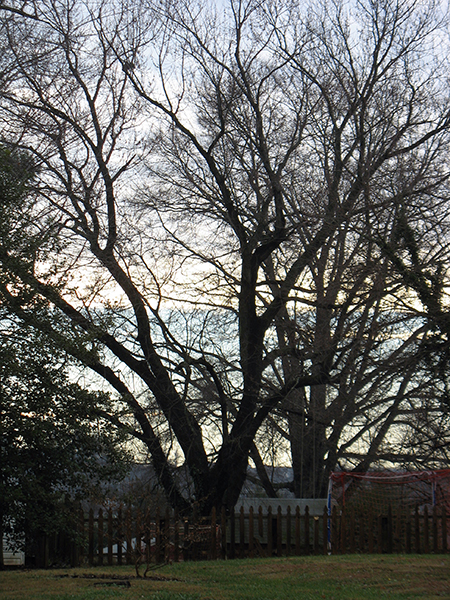
weigh heavy,
dragging at my soul
a beckoning clarity
gleams impossibly distant, remote
In memory of my mother:
Bereaved
Grief
Lament
Missing Her
One Crossing
Grievous Loss


In memory of my mother:
Bereaved
Grief
Lament
Missing Her
One Crossing
Grievous Loss
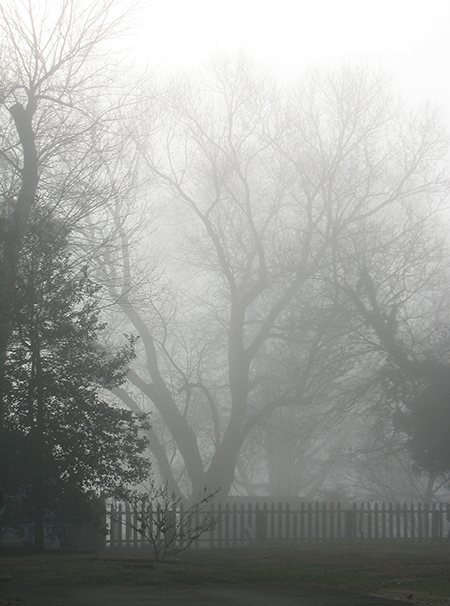
In memory of my mother:
Mourning
Grief
Lament
Missing Her
One Crossing
Grievous Loss
I love Lindsey Stirling’s “The Arena.”
It’s so beautiful, so powerful. And, because I’m an artist myself, its message expresses something deep within my own heart.
Every artist who shares her work with others must brave the indifference or contempt of her audience. Every artist who creates must confront her own implacable inner judge.
“It is not the critic who counts;
not the man who points out how the strong man stumbles,
or where the doer of deeds could have done them better.
The credit belongs to the man who is actually in the arena…”– Theodore Roosevelt,
“Citizenship in a Republic”
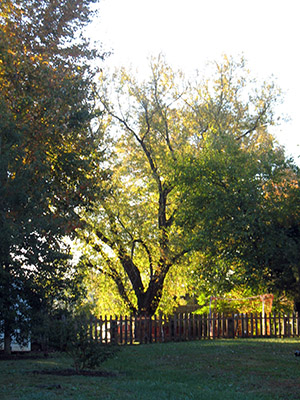 Whenever I see sunlight shining through tree leaves or blades of grass, it seems magical: Nature’s stained glass windows.
Whenever I see sunlight shining through tree leaves or blades of grass, it seems magical: Nature’s stained glass windows.
As the year winds into autumn, I’ve been getting my morning sunlight on my front porch. The back deck, on the west side of my home, is perfect for the warm weather of summer. It’s shady and catches the least hint of breeze. In cool weather, that hint of breeze turns into gusts of wind, and the shadows chill. Thus my change of venue. 😀
The front yard is sheltered and sunny. On mild days – like today – the pocket of warmth means I can doff my hat and gloves! (I’ve been wearing a fingerless glove on my right hand, so that I can write in my journal while I’m outside.)
 The trees across the street have been particularly beautiful, with the rising sun shining through them.
The trees across the street have been particularly beautiful, with the rising sun shining through them.
So many of the early mornings this summer were beautiful. That of September 5th charmed me so utterly that I wrote about it in my journal. Since I am head down in the exciting final scenes of my current novel – and prefer not to take sufficient time away from it to write a blog post – I’m going to share that morning with you. 😀
Clear sky this morning, deep blue to the south, paler hue overhead, shading down to a soft warm white above the mountains to the west.
Crickets sing in the grass, their droning music punctuated by small tuneful chirps, crows in the distance, melodic twitters from songbirds nearer by. Sun brightens the trees of the slope across the way. Magical.
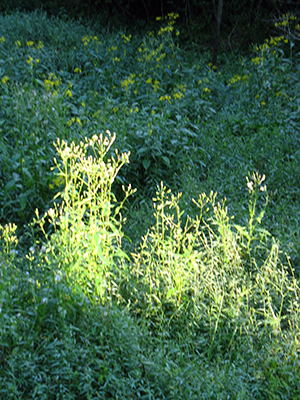 The back yard is still in shadow, muted greens; golden light hits the upper branches of the holly, so tall it rises above the ridge.
The back yard is still in shadow, muted greens; golden light hits the upper branches of the holly, so tall it rises above the ridge.
The inner reaches of the maples are quite lovely, a mosaic of shadowed leaves and sunlit ones with pieces of sky showing through.
. . . “the same summer will never be coming twice.” Never quite the same.
quote from
Anne of Ingleside,
L.M. Montgomery
When my kids were little, I introduced them first to fingerpainting and then to watercolors. The fingerpainting stage was messy. I would cover their toddler table with a large plastic leaf bag and robe them in smocks and stand vigilant to steady the water bowl they used to rinse their hands when they wanted to switch colors.

But when they were old enough for watercolors, the level of supervision could be considerably less. So I joined them in the fun. I’d cover the entire dining room table with leaf bags, set out three sets of paints and three cups of water for rinsing brushes, and sit down with them. We had some lovely times painting together. And I found that I enjoyed the painting almost as much as I enjoyed the time with my children.
I remembered that I’d loved drawing since I was a kid myself, and wondered if it might be good to reactivate this interest. I read a few chapters of Drawing on the Right Side of the Brain, but it seemed overly ambitious for me at that moment. So I poked around online and stumbled upon the Zentangle® website.
I loved what I saw there, but the starter kit was $50, a little steep for something I just wanted to experiment with. So I bookmarked it for later and went on with my life, breaking out the watercolors every now and then, even after my kids were no longer interested.
To be honest, I forgot all about Zentangles until this June, when I decided I needed a quiet activity for the evenings that didn’t involve a computer screen or a TV screen. I tried an adult coloring book, but that didn’t quite work for me. And then I remembered…something.
“Wasn’t there some kind of pen-and-ink drawing?” I said to myself. “It looked really cool. I remember I wanted to try it, but it was awfully expensive. What was the name of it?”
As you can see, my memory was very sketchy. All I had was the picture in my mind of that cool black-and-white drawing.
Luckily, I had bookmarked the site with the info. Even more luckily, I found the bookmark when I went scrolling through the hundreds of bookmarks that I’ve created. (I bookmark a lot of pages when I’m researching for my novels.)
I clicked the bookmark, it directed me to the correct site, and I said, “Oh, yeah! That’s it!” when I saw it. But I still couldn’t go for the $50 price tag.
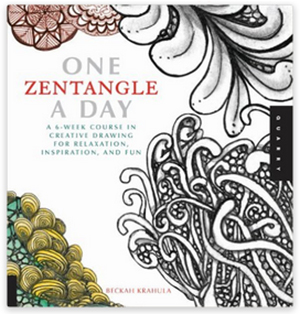 “I wonder if there’s a book about this on Amazon?”
“I wonder if there’s a book about this on Amazon?”
You can guess the answer. There was. It was reasonably priced. And it looked like it would have just the how-to information I wanted. I purchased One Zentangle a Day and leaped on it when it arrived.
The book is not perfect. The author includes a fair bit of verbiage on shading and use of color which is not a part of the Zentangle method, although it can be used with Zentangle-inspired art. Unfortunately, this extraneous material is not particularly well explained. However, I didn’t get the book for instruction in shading or using color.
Zentangling is essentially an exploration of pattern and how different patterns can be fitted together. It’s a new name for a very old pastime.
The book presents three new patterns at a time, showing how to draw each one step by step. With each set of patterns is an example of a drawing that features them (usually mixed with a few more). You, the reader, are instructed to practice the patterns first and then to draw your own Zentangle using the new patterns, together with a few of the other patterns you’ve already learned.
So I’ve been doing just that, and it’s been a lot of fun. It has proven an excellent evening activity when I’m not in the mood to read or when I’m too tired to do anything else.
Here are some of my practice squares of patterns I learned during the first 4 days I used the book.

The first couple of weeks, when I drew my own Zentangle, I always used the new patterns plus a few of the older ones when the design seemed to call for them. Lately, my designs seem to demand that I use only two of the new patterns instead of all three. Since I’m doing this for fun, I go with my inspiration. It means that I’m getting “behind,” in that I’m collecting patterns I have yet to use, but who cares! I’m not in any hurry to reach the end of the book.
Here’s the Zentangle I drew using the patterns shown above.
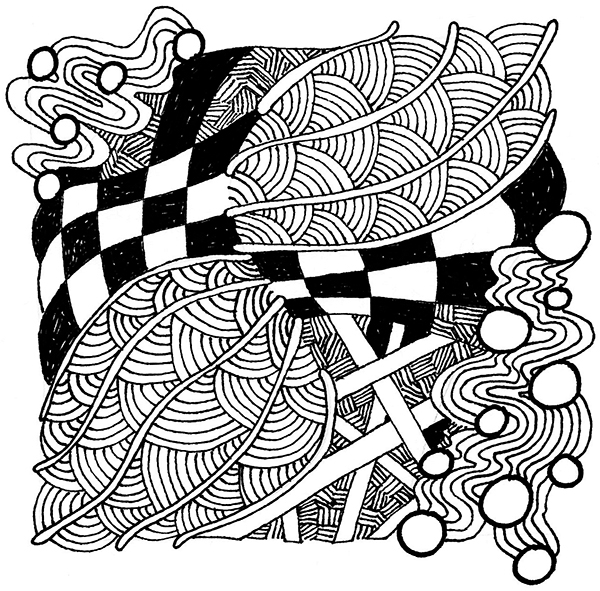
What do you think? Does it look like fun to you? What do you do when you need something quiet, but engrossing?
Cooler air, dampness rising from cold earth, gray skies.
The season turns, and I turn inward, seeking warmth.
Warmth of the hearth, warmth of the heart, blankets.
I laugh with my family. I simmer soup on the stove. Here in the heart of our home.
Then comes a pale, clear day when the sun and the flaming trees astonish me.
Warmth of beauty draws me out.
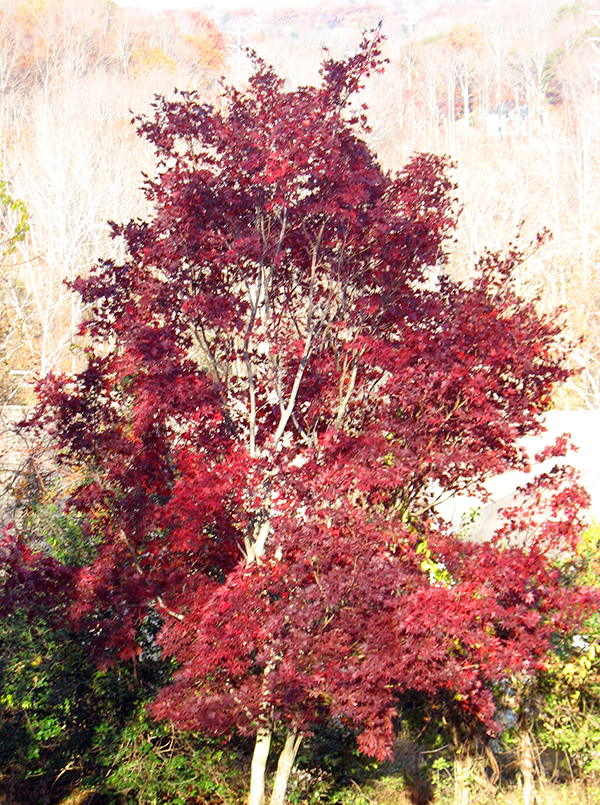
For more photos:
An Autumn Branch
Blossom
Kay Nielsen rejuvenated my writing career.
How? It was his illustrations for East of the Sun and West of the Moon that did the deed.
I’ve told the story of how I discovered my creative process in an earlier post. Strangely, I’d engaged in my creative process for decades without recognizing it for what it was. Which meant that when I attempted to make the switch from one type of creativity (game design and graphic design) to another (narrative fiction), I didn’t know how to go about it. I tripped and fell.
Dorothea Brande’s Becoming a Writer sorted out my thinking. Ready to give my old ways a new try, I needed inspiration.
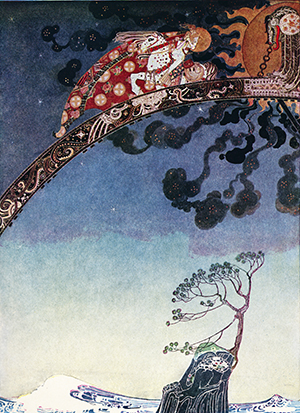 Kay Nielsen’s illustration in the title story of East of the Sun – captioned “And flitted as far as they could from the Castle that lay East of the Sun and West of the Moon” – came to mind almost the instant I began the meditation that kicks off most of my writing.
Kay Nielsen’s illustration in the title story of East of the Sun – captioned “And flitted as far as they could from the Castle that lay East of the Sun and West of the Moon” – came to mind almost the instant I began the meditation that kicks off most of my writing.
Now, I adore that painting, but I resisted it as the inspiration for my tale. Why? Mainly because I thought one of the quirkier works in the collection might make a more unusual starting point. And unusual appeals to me.
Fortunately my inner storyteller refused to budge. The story of the lassie carried away by a white bear is a great one, and Nielsen’s illustrations for it – both black & white line drawings and color paintings – utterly beguiled my imagination.
As I mused, my North-lands were born along with cursed Prince Kellor, half crazy in the darkness during the night when he regains his man’s form. That first scene – Kellor struggling to think clearly – almost wrote itself. And you know the rest: I completed and published Troll-magic.
Then I wrote about Sarvet, a character with one small walk-on part in the second-to-last chapter of Troll-magic. And then I wrote another story about the Hammarleedings, Sarvet’s mountain people. I suspect I’ll be writing stories in my North-lands for a long time. All because of Kay Nielsen.
As well as being the creative inspiration behind my fantasy world, his work also appears on my web sites and graces the covers of three of my books. I stand on the shoulders of a titan.
So I want to tell you a little about him.
First, his name. As an English speaker, I would naturally pronounce Kay to rhyme with weigh or inveigh or, more simply, may. And I would be wrong. It’s pronounced “Kie,” rhyming with pie or vie. (Yes, I’ve always liked rhyming games. 😀 ) Nielsen is more straightforward. “Neelsun.”
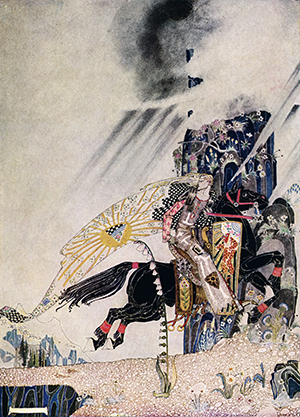 So, Kay Rasmus Nielsen was Danish, born in Copenhagen in 1886. His parents were actors, his mother a very famous one and his father the director of the Dagmar Theater. He studied art in Paris, then lived in London, where he received a commission from a British publisher to illustrate a collection of fairy tales.
So, Kay Rasmus Nielsen was Danish, born in Copenhagen in 1886. His parents were actors, his mother a very famous one and his father the director of the Dagmar Theater. He studied art in Paris, then lived in London, where he received a commission from a British publisher to illustrate a collection of fairy tales.
No, this wasn’t East of the Sun, the collection of Norse folk tales. Titled In Powder and Crinoline, it included more continental stories such as “The Sleeping Beauty” and “The Twelve Dancing Princesses.” Nielsen’s illustrations featured courtiers garbed in sweeping ball gowns and cavalier coats along with towering white wigs. Cool stuff! I’m thinking I might try to acquire a copy.
The commission for East of the Sun came the next year, to be released in 1914. Both books utilized the new four-color process of printing to wonderful results. The previous method – three-color process – tended to produce darker colors that looked dirty and muddy. Kay Nielsen’s color plates possess clear, true tints from light to dark.
Of course, these commissions weren’t the whole of his professional life. He created scenes from the life of Joan of Arc, he painted landscapes in Dover, he traveled to New York for an exhibition of his work. He painted stage scenery for the Royal Danish Theater.
In 1924, he returned to book illustration with color plates and monotones for Fairy Tales by Hans Christian Andersen and Hansel and Gretel and Other Stories by the Brothers Grimm.
In 1939, he worked in Hollywood, eventually landing a job with Disney! I’d no idea, back in my childhood when I read and re-read East of the Sun, that the illustrator of those marvelous old-fashioned pictures was involved in something so modern as the movies. The “Ave Maria” and “Night on Bald Mountain” sequences in Fantasia were his work. He grew famous in the biz for all the concept artwork he did for Disney films.
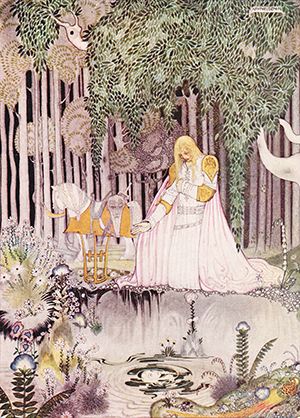 Sadly, all the beauty and genius of his work did not secure honor and security for his old age. His illustrative style fell out of fashion, and he died in poverty in 1957. He deserved far better. He delighted my childhood, as I imagine he did for many who read the books he illustrated or saw the movies he influenced. He sparked my own creativity. I see him as one of the greats of history.
Sadly, all the beauty and genius of his work did not secure honor and security for his old age. His illustrative style fell out of fashion, and he died in poverty in 1957. He deserved far better. He delighted my childhood, as I imagine he did for many who read the books he illustrated or saw the movies he influenced. He sparked my own creativity. I see him as one of the greats of history.
Live long in our admiration of your art, Kay Nielsen!
A light sprinkling of snow.
Just enough for winter beauty.
Not enough for winter inconvenience. 😀

For more photos:
Blossom
Wild Garden
Twelve dancing princesses in the fairy tale of that name descend a secret stair – not dancing while descending, however 😀 – and pass through three magical woods. Depending on the version in your book, the first glade of trees features leaves of bright copper, the second, flowers of shining silver, and the third, fruits of gleaming gold.
Fifty princes have sought to learn the princesses’ secret and failed.
When a modest gardener boy takes up the quest, he secures an advantage: a cloak of invisibility. Hidden by its powers, he follows the princesses to their midnight revels.
As proof of his journey, when he returns from the underworld, he breaks a twig from a tree in the copper wood.
This branch in my own garden reminds me of the gardener boy’s earliest prize.

For more photos:
Tree Rocket
Blossom